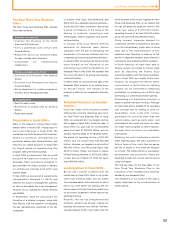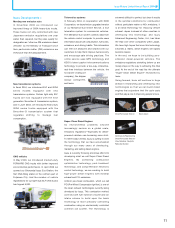Isuzu 2004 Annual Report Download - page 13
Download and view the complete annual report
Please find page 13 of the 2004 Isuzu annual report below. You can navigate through the pages in the report by either clicking on the pages listed below, or by using the keyword search tool below to find specific information within the annual report.
Developing cleaner vehicles
>>
We have been able to solve technologically
difficult problems by combining new
technologies such as super-high pressure
fuel injection, exhaust gas recirculation,
catalytic oxidation, and the use of 16
valves.
Isuzu took the lead in meeting Japan’s
tougher new emissions regulations when
we launched the new line up ELF-KR light-
duty trucks in June 2002, complying with
the new rules one-and-a-half year earlier
than required.
In fiscal 2004 we have continued to
introduce new, more environmentally
friendly models. In May 2003, we launched
medium-duty FORWARD CNG trucks with
further improved environmental
performance, and in November 2003 we
introduced the improved lineup of GIGA
heavy-duty trucks that conformed to new
Japanese emission rules for 12-ton and
bigger trucks one year earlier than required.
We have also equipped our ELF and GIGA
series trucks with new “Smoother” series
transmissions that help manage fuel
consumption. Finally, we opened the first
CNG filling station in the northern part of
Fujisawa City, and vehicle registrations for
our ELF CNG trucks topped 5,000.
Minimizing the impact of
manufacturing
>>
Isuzu has been working to minimize the
impact of our manufacturing facilities on the
environment by involving all of our employees
in adopting original new methods. We realize
that we need to put still more effort into this
endeavor, but we are confident that our
unflagging commitment to the development of
new technologies will help us work our way to
the forefront in this area.
Indeed, though we still have room to improve,
many our initiatives have been already been
successful, and we have sharply reduced the
volume of waste and CO2emissions
generated by our plants. In fact, our current
CO2emissions are already below the target
that we originally set for 2010. We have done
this by consolidating production lines,
eliminating steam and air discharges and
machine idling, using inverters on pumps to
optimize efficiency, minimizing loss of
compressor operation by changing lubricants,
and stopping air blowing in mechanical
washing equipment.
Social responsibility
>>
In addition to our efforts to prevent accidents
in the workplace, Isuzu has instituted “Total
Health” programs for our employees and their
families with the aim of preventing lifestyle
diseases. We sponsor group hikes and other
physical health activities, and we also
promote programs to encourage individuals to
quit smoking, exercise, maintain a healthy diet
and restrain alcohol consumption. We also
provide a mental health program where
specialists provide free counseling.
Since we are fully aware that our employees
are our most important asset, we have
developed a companywide employee
education program that complies with ISO/QS
9000 standards.
Isuzu has changed its employment practices
in line with relevant legislation, and we do not
discriminate by gender in the recruiting,
training, and treatment of our employees. We
actively recruit motivated and talented
individuals regardless of gender and we strive
to create a workplace that is comfortable for
all of our employees.
For more information on Isuzu’s environmental
and social activities, please refer to our
Environmental Report 2003, which is available
on our website.
http://www.isuzu.co.jp/world/environment/report/
13
Isuzu Motors Limited Annual Report 2004
Isuzu Environmental Charter
>>
Environmental policies
1. We will work proactively to protect the environment throughout the entire product lifecycle—from
vehicle manufacturing to usage, and final disposal.
2. To leave behind a beautiful earth for our children, as citizens of the earth we will actively participate
in environmental protection activities aside from our business actions.
Environmental code of conduct
1. We will strive to minimize energy consumption and control emissions in the manufacturing process
to protect the environment.
2. In developing and manufacturing vehicles, we will strive to minimize the emissions and noise
generated by vehicle operation. We will also work to protect the environment by developing
logistics systems that take rational distribution into consideration.
3. Since resources are finite, we will strive to offer vehicles that will be appreciated by their owners
for many years. We will also take into consideration the need for recycling to ensure the reuse of
materials when it comes time to finally dispose of a vehicle at the end of its useful life.
—Adopted in May 1992
























